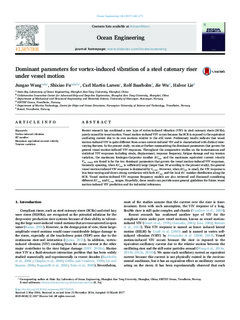| dc.contributor.author | Wang, Jungao | |
| dc.contributor.author | Fu, Shixiao | |
| dc.contributor.author | Larsen, Carl Martin | |
| dc.contributor.author | Baarholm, Rolf | |
| dc.contributor.author | Wu, Jie | |
| dc.contributor.author | Lie, Halvor | |
| dc.date.accessioned | 2017-11-10T08:35:52Z | |
| dc.date.available | 2017-11-10T08:35:52Z | |
| dc.date.created | 2017-08-04T11:18:55Z | |
| dc.date.issued | 2017 | |
| dc.identifier.citation | Ocean Engineering. 2017, 136 260-271. | nb_NO |
| dc.identifier.issn | 0029-8018 | |
| dc.identifier.uri | http://hdl.handle.net/11250/2465444 | |
| dc.description.abstract | Recent research has confirmed a new type of vortex-induced vibration (VIV) in steel catenary risers (SCRs), purely caused by vessel motion. Vessel motion-induced VIV occurs because the SCR is exposed to the equivalent oscillating current due to its own motions relative to the still water. Preliminary results indicate that vessel motion-induced VIV is quite different from ocean current-induced VIV and is characterized with distinct timevarying features. In the present study, we aim at further summarizing the dominant parameters that govern the general vessel motion-induced VIV responses. Throughout the comparative studies on the instantaneous and statistical VIV responses including strain, displacement, response frequency, fatigue damage and top tension variation, the maximum Keulegan-Carpenter number KCmax and the maximum equivalent current velocity Vn_max are found to be the two dominant parameters that govern the vessel motion-induced VIV responses. Generally speaking, when KCmax is sufficiently large (larger than 39 according to the present study), the general vessel motion-induced VIV response is dominated by Vn max. However, when KCmax is small, the VIV response is less time-varying and shows strong correlation with both KCmax and the local KC number distribution along the SCR. Vessel motion-induced VIV response frequency models are also reviewed and discussed considering different KCmax and Vn max ranges. Hopefully, these results can provide some general guidelines for future vessel motion-induced VIV prediction and for industrial references. | nb_NO |
| dc.language.iso | eng | nb_NO |
| dc.publisher | Elsevier | nb_NO |
| dc.rights | Attribution-NonCommercial-NoDerivatives 4.0 Internasjonal | * |
| dc.rights.uri | http://creativecommons.org/licenses/by-nc-nd/4.0/deed.no | * |
| dc.title | Dominant parameters for vortex-induced vibration of a steel catenary riser under vessel motion | nb_NO |
| dc.type | Journal article | nb_NO |
| dc.type | Peer reviewed | nb_NO |
| dc.description.version | acceptedVersion | nb_NO |
| dc.source.pagenumber | 260-271 | nb_NO |
| dc.source.volume | 136 | nb_NO |
| dc.source.journal | Ocean Engineering | nb_NO |
| dc.identifier.doi | 10.1016/j.oceaneng.2017.03.015 | |
| dc.identifier.cristin | 1484160 | |
| dc.description.localcode | © 2017. This is the authors’ accepted and refereed manuscript to the article. LOCKED until 21.3.2019 due to copyright restrictions. This manuscript version is made available under the CC-BY-NC-ND 4.0 license http://creativecommons.org/licenses/by-nc-nd/4.0/ | nb_NO |
| cristin.unitcode | 194,64,20,0 | |
| cristin.unitname | Institutt for marin teknikk | |
| cristin.ispublished | true | |
| cristin.fulltext | postprint | |
| cristin.qualitycode | 1 | |

